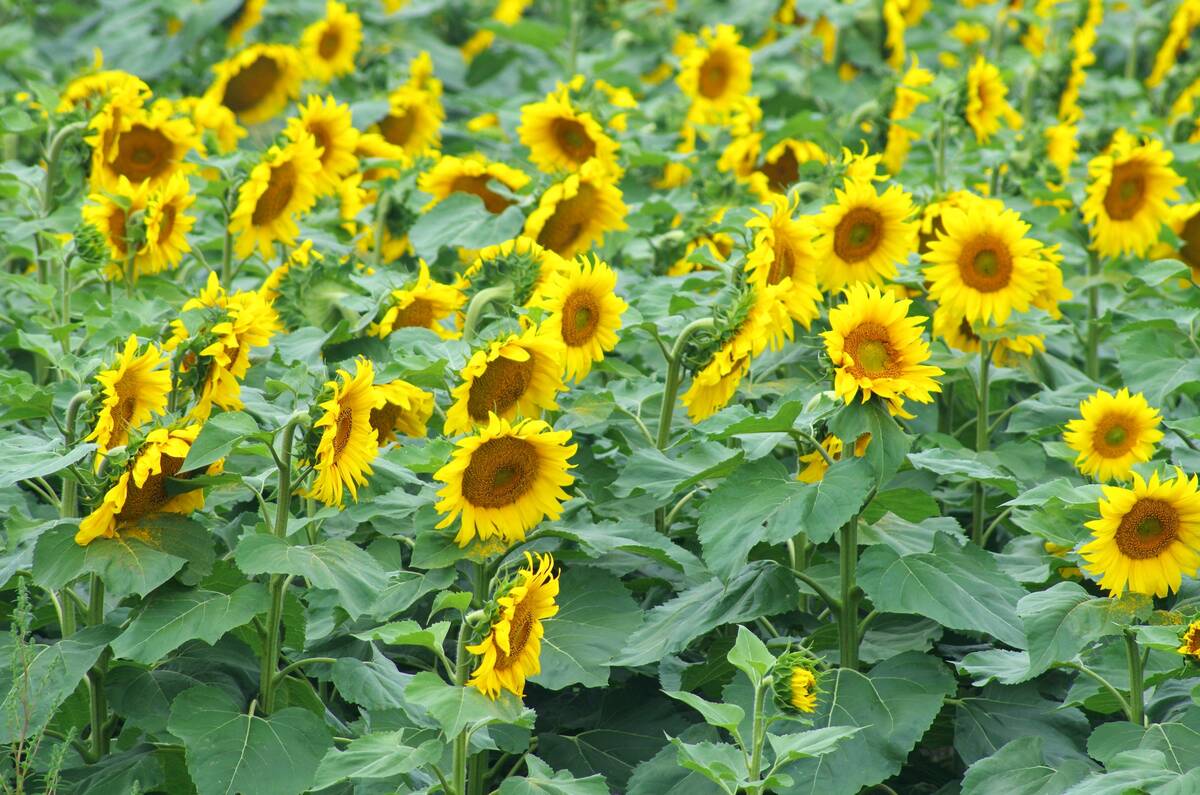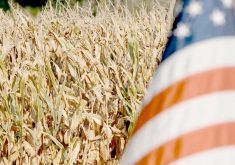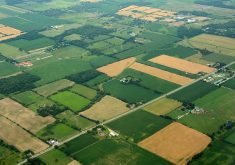Governments are responding to agricultural, municipal and homeowner damages caused by heavy rainfall and storms across the Prairies this spring and summer. In this special report, Western Producer reporter Karen Briere surveys the response and digs into the details beyond the announcements.
YORKTON, Sask. – Prime minister Stephen Harper received a bird’s-eye view last week of what many farmers have been coping with on the ground for months.
He and Saskatchewan premier Brad Wall left the Yorkton airport in a Griffon helicopter just hours after the country’s agriculture ministers wrapped up meetings in Saskatoon by announcing a $450 million Agri-Recovery flood aid package for prairie farmers.
Read Also

Bird repellent gets emergency approval for sunflowers
Bird repellent gets emergency approval for sunflowers
They spent 30 minutes in the air over the Canora and Good Spirit Lake areas before landing near the farmyard of Ron and Brenda Blommaert, northwest of Yorkton, on land that had been too wet for the couple to seed.
The Blommaerts have been farming for 35 years and this year seeded about 80 percent of what they intended. Ron Blommaert said he has never before been unable to seed all the land he planned to seed.
“It’s just a guess, but we maybe lost about another 10 to 15 percent due to flooding,” he said.
Farmers are fretting now but it will be worse in the fall, he added.
“When we don’t have anything to sell, we have no income,” he said.
Viterra estimates that seeded area in Western Canada is eight to 10 million acres less than the five-year average of 60 million and that production will be down accordingly.
About eight million Saskatchewan acres went unseeded and up to four million more could be drowned out, according to the province’s agriculture ministry.
Farm assistance programs will have to prove their worth this year.
Saskatchewan will receive the largest share of the $30 per acre AgriRecovery package at $360 million. Alberta farmers will receive $60 million for an estimated two million wet acres, while Manitoba farmers will receive $30 million on one million acres.
The payments are available to all affected producers and are in addition to crop insurance and AgriStability, two federal-provincial programs into which governments already sink a lot of money.
Saskatchewan will have to add more to both.
Saskatchewan agriculture minister Bob Bjornerud said the province expects it will have to add $100 million to its AgriStability budget for 2010 payments and at least $300 million to crop insurance for its $50 per acre unseeded acreage benefit.
Unseeded area is typically 600,000 acres, Bjornerud said.
Shawn Jaques, executive manager of field operations at Saskatchewan Crop Insurance Corp., said the most unseeded acreage claims in recent history came in 2006 when the corporation paid out $62 million on 1.24 million acres.
Claims for yield losses won’t come in until the fall, but officials are already bracing for big payouts.
The weather woes should also trigger AgriStability payments because most farmers will have fairly high reference margins after two strong years, said SCIC general manager Cam Swan.
SCIC took over administration of AgriStability from Ottawa this year and advance interim payments for 2010 are already available.
Norm Hall, who farms near Wynyard, Sask., said some farmers are wary of advances.
He said some who took advances under the federally guaranteed advance payments program are wondering what happens next.
The advances are to be paid back first from production and then from business risk management programs such as AgriStability.
However, Hall wondered how farmers can pay back the money if they took the advance, spent it on seed and fertilizer and didn’t seed an acre.
As well, AgriStability advances would go to settling the previous debt.
“Luckily we had a large crop last year,” Hall said. “Maybe it won’t put them right under.”
Blommaert said the impact of this year will be felt next spring, when cash advances are non-existent.
He hopes Harper won’t forget about farmers now that he has seen the damage first hand.
The prime minister did not speak to reporters after his tour but spent about 90 minutes talking in private with Blommaert and several neighbours.
Blommaert said the prime minister was attentive, easy to talk to and answered tough questions.
“It was like sitting down having coffee with somebody,” he said. “I think he was very receptive to our needs.”
However, most observers acknowledge that $30 per acre will do little more than help pay for weed control, assuming farmers can get on their land to spray.
Blommaert said this year will test the efficiency of the federal-provincial business risk management programs.
“If they don’t work now, they’re useless.”
Canada-provincial excess moisture program
60 per cent funded by Ottawa, 40 per cent funded by provinces
$30 per eligible acre
Too wet to seed as of June 20 or seeded crop lost because of flooding on or before July 31
Deadline to apply is Sept. 30
Farmers not enrolled in crop insurance will need to fill out an application form
Crop insurance customers will not have to apply unless established crop was flooded between June 20 and July 31. Acres damaged after June 20 require an application form
Forms are available at www.saskcropinsurance.co m and at crop insurance and rural municipality offices
Sask. Crop Insurance information line is 888-935-0000
Alberta
The $200 million 2010 Southern Alberta Disaster Recovery Program will apply to residents in the following places:
Counties:
-Cardston
-Cypress *
-Forty Mile*
-Lethbridge
-Newell
-Warner
Municipal districts:
-Pincher Creek
-Taber*
Towns:
-Bow Island*
-Cardston
-Coaldale
-Fort Macleod
-Magrath
-Pincher Creek
-Raymond*
-Redcliff*
-Taber*
-Vauxhall*
Villages:
-Cowley*
-Duchess
-Foremost*
-Glenwood*
-Hill Spring
-Stirling
-Warner
Other:
-Blood Tribe First Nation*
-Piikani Nation First Nation
-Brooks
-Lethbridge
-Medicine Hat*
* These areas also qualify for $3.5 million 2010 Spring South Eastern Alberta Disaster Recovery Program.
To process applications, registration centres will open across southern Alberta starting on July 7. For more information on the program visit aema.alberta.ca.
Saskatchewan
Rural municipalities:
-Arlington
-Bayne
-Big Stick
-Birch Hills
-Birch Hills
-Buchanan
-Cana
-Colonsay
-Elmsthorpe
-Flett Springs
-Foam Lake
-Good Lake
-Hazel Dell
-Hoodoo
-Humboldt
-Insinger
-Invergordon
-Invermay
-Ituna Bon Accord
-Kinistino
-Lake Lenore
-Lakeview
-Leroy
-Lost River
-Maple Creek
-McRaney
-Morris
-Mount Hope
-Nipawin
-Ponass Lake
-Sasman
-St. Louis
-St.Peter
-Star City
-Three Lakes
-Torch River
-Viscount
-Wolverine
Towns:
-Burstall
-Canora
-Central Butte
-Colonsay
-Dundurn
-Foam Lake
-Gull Lake
-Hanley
-Lanigan
-Leader
-Leroy
-Maple Creek
-Nokomis
-Osler
-Preeceville
-Warman
-Watrous
Villages:
-Annaheim
-Buchanan
-Englefeld
-Hawarden
-Invermay
-Kenaston
-Margo
-Meath Park
-Middle Lake
-Rama
-Spalding
-Viscount
Other:
-Humboldt
-Saskatoon
-Yorkton
-Neekaneet First Nation
Manitoba
Rural municipalities:
-Alonsa
-Armstrong
-Arthur
-Blanshard
-Brokenhead
-Cartier
-Coldwell
-De Salaberry
-Edward
-Ethelbert
-Ethelbert
-Fisher
-Franklin
-Franklin
-Grahamdale
-Grandview
-Grandview
-Grey
-Hanover
-Killarney-Turtle Mountain
-La Broquerie
-MacDonald
-McCreary
-Minitonas
-Montcalm
-Mossey River
-Mossey River
-Mountain
-North Norfolk
-Ochre River
-Pipestone
-Ritchot
-Rockwood
-Rosedale
-Rosedale
-Sifton
-Sifton
-Siglunes
-South Norfolk
-Ste. Rose
-Strathclair
-Strathcona
-Stuartburn
-Swan River
-Tache
-Victoria
-Whitehead
-Whtetmouth
-Woodlands
-Woodworth
Towns:
-Emerson
-Oak Lake
-Neepawa
Other:
-Brandon
-Selkirk
-Peguis First Nation[

















